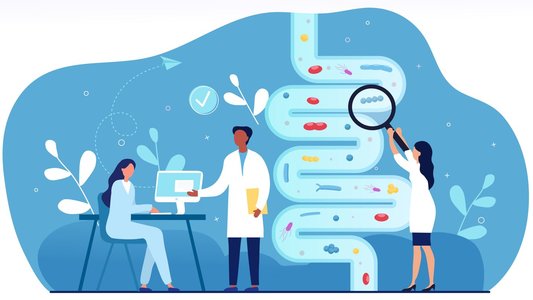- How personalized nutrition is changing the game
- The importance of digital tools for consumer-relevant health research
- Big data, Artificial Intelligence, and simulated research
- Balancing the push of science with the pull of commercial valorization
Scientists are guided by innovation and technology

Big developments in science are always driven by technology. From genome sequencing to high-performance computing, the interplay between cutting-edge research and emerging tech has been rewarding scientists for centuries. For scientists today, harnessing the new technologies and innovations that are emerging year after year is fundamental. They show us routes into an exciting future. One of the biggest examples of this is the emergence of big data and Artificial Intelligence (AI), which has striking ramifications for the health and nutrition industry.
Big Data, AI, and the future of research
In nutritional science, big data and AI will change the game. With the sheer quantity of data being collected and analyzed across the industry, we are beginning to piece together a more accurate image of how nutrition impacts the human body. This also includes our company’s specific niche: collagen’s impact on health and fitness. Where could this lead? Perhaps in 10 years, our industry might use data in tandem with AI to make accurate simulations before testing in a clinical setting.
As simulation becomes an ever more viable form of research, we could be able to predict whether a specific collagen formulation can aid a certain segment of the population to manage certain conditions – a random example might be, say, that a specific collagen product might help to maintain eyesight among a specific group of people. While we can’t predict how far this will take us, it’s clear that today’s technological advancements can unlock research areas that were previously inaccessible, letting us delve into collagen’s impact on cutting-edge health benefits that will benefit very specific groups of people – based, for example, on age brackets, health conditions, lifestyle, or physical build. It will also speed up the innovation process, with more insights emerging more quickly all the time.

The age of predictive nutritional insights may not be that far away. Of course, today we already predict in very generic terms, it’s what preventative solutions are built on: we can tell people based on science that Peptan can support them in sports recovery, or Colartix in joint health. Consumers are excited about that kind of insight. And they have been satisfied with that until now. But gradually they are expecting more: with the growing awareness of the diversity of personal health profiles, research outcomes and solutions, they want more and more personalized advice. They want us to be able to tell them what supplements to take today in order to avoid issues tomorrow.
Merging tradition and innovation with digital tools
Coming back to our work today, integrating new tech is already shaping what and how we can study in a practical research context. By leveraging digital tools in research – think, for example, of adopting 24-hour live monitoring, metabolic screeners, or accurate samplers - scientists can track and record an unparalleled amount of data. And they can do this relatively simply and easily now, while improving the experience for participants too. These new tools also open the door to research among populations who don’t have the time or opportunity to come to study centers. Altogether, digital tools will offer researchers a broader insight into real-life consumer health, providing a greater understanding of the impact of certain supplements. By introducing fresh elements like these, and combining tradition and innovation, we can move in exciting directions, ushering in a new age of consumer-relevant science. One recent example of this is GutMe!, a study that used a mixed-method methodology with digital tools to learn about collagen and gut health.

With digital tools, the possibilities are significant. In the past, nutrition researchers needed to unpack how a supplement’s impact on an individual affects their overall health – a complex process. But imagine, for example, if you had a real-time snapshot of a participant’s digestive system, combining all the real-time data being recorded, you could see the influence of weight loss, microbiomes, glucose levels, or certain metabolites – all at once. This would give scientists more insight than ever before into an individual’s body and its responses to different treatments and supplements. As we map these minute reactions, we can create solutions tailored to unique issues. A tool like this offers the complex information needed to highlight the response of an individual; from that, we can look for wider patterns amongst the population– corresponding to the rise of personalized nutrition.
Personalized solutions for unique consumers
The body is such an incredibly complex system: there are so many interlocking strands to untangle. And each individual human has traits and characteristics that affect their overall health in unique ways that we want to learn to identify and navigate. From genes and gender to age, lifestyle, and activity level. Biology shows us that we are all different – and that how we respond to things like food, activity or disease is different too. More consumers are beginning to recognize this, looking for personal solutions that are right for them. This is how consumers are pushing the rise of personalized nutrition.

In the future, I can see us developing multiple differentiated products from collagen for multiple target groups and purposes. Some of them might appear to be the same white powder we’re familiar with, tasting, smelling, and looking the same, but have specific bioactivities that bring out certain benefits, designed through targeted production processes. This is a new research area already shaping our work and it is very exciting. The push in research toward more selected cohorts helps us here – we might choose to run a study on female athletes who are all 30-40 years old, and even from a specific country or with a specific lifestyle, giving us more information on that specific segment of the population.
Balancing science, communication, and commercial success
The essential question in science is ‘why?’ In a company like Rousselot, having the courage, simplicity, and patience to continually ask this question is indispensable. When I first joined the team, one of my responsibilities was organizing the clinical and pilot studies: I needed to ensure everything was carried out correctly - within budget, double-blind, placebo-controlled, and more. When working on studies like that, one of the key questions was and is always about its relevance to consumers. What and who do we want to address with this research, and why? What is our purpose here, what are we hoping to achieve?

It’s nice to have a lot of data, but we need to ensure the data are placed in the context of real people’s lives. As Rousselot balances fundamental scientific research with commercial application, we can feel this tension in action every day. Scientists’ job is to find and develop new topics and technical possibilities, while the commercial colleagues’ job is to identify the value of an idea for the customer. This push-and-pull is so useful to us. Innovative science is all about connecting the dots. Putting everything on the table, and mixing it up, let us see things from a new perspective. If we’re stuck with either our ‘scientist’ or ‘commercial’ hats on, it’s hard to make it flow. This also explains why we are increasingly involving more disciplines in our research. In the future of science, I can easily imagine health and nutrition scientists collaborating with experts for different health disciplines, for market and consumer insights, for digital tools, and maybe innovative delivery format development to explore all the new terrain lying open before us. It is often from the interfaces between disciplines that the most surprising insights emerge.
DISCLAIMER:
Rousselot makes no representation or warranty, whether expressed or implied, as to the accuracy, reliability, or completeness of the information, nor does it assume any legal liability, whether direct or indirect, for any information. Use of this information shall be at your discretion and risk. Nothing herein relieves you from carrying out your own suitability determinations and tests and from your obligation to comply with all applicable laws and regulations and to observe all third-party rights. This product is not intended to diagnose, treat, cure, or prevent any disease.
